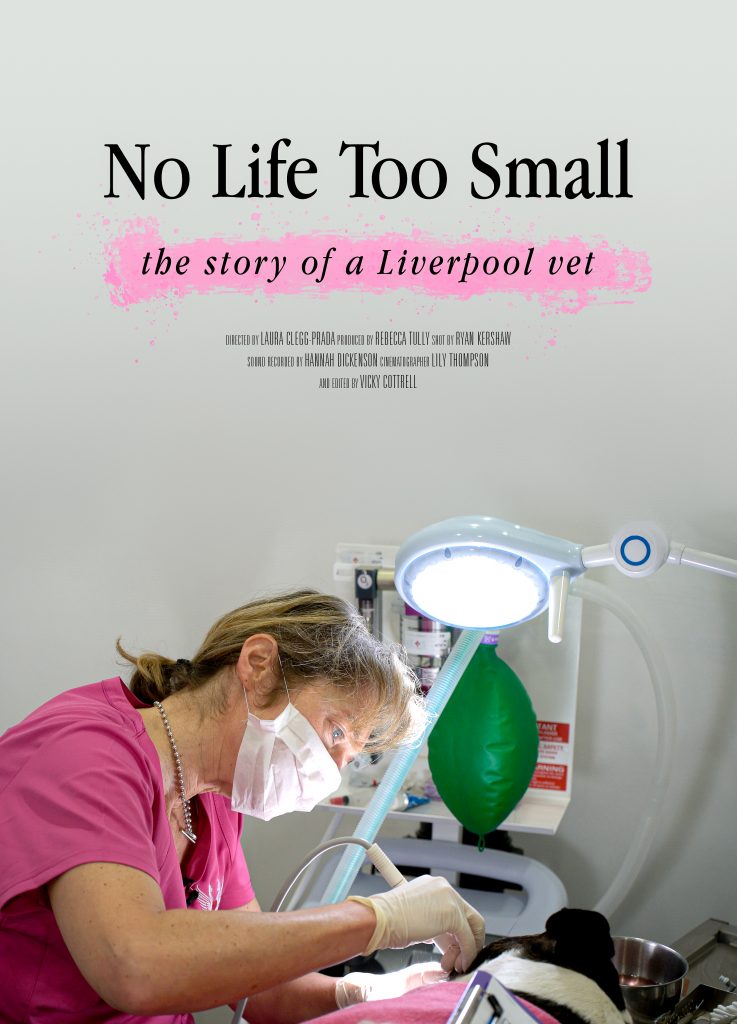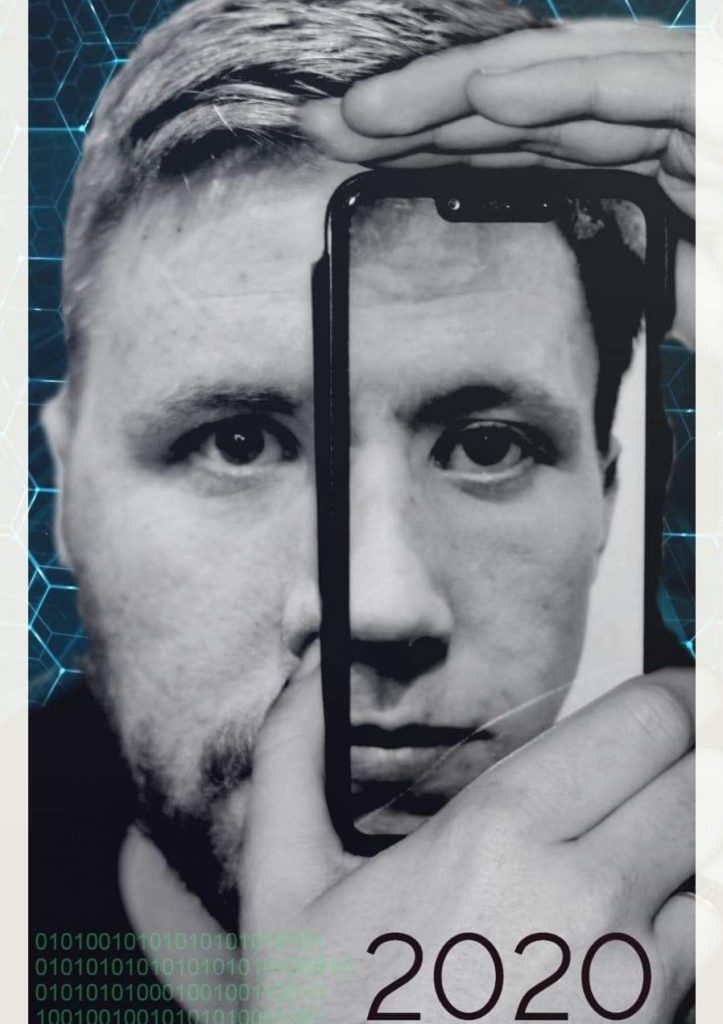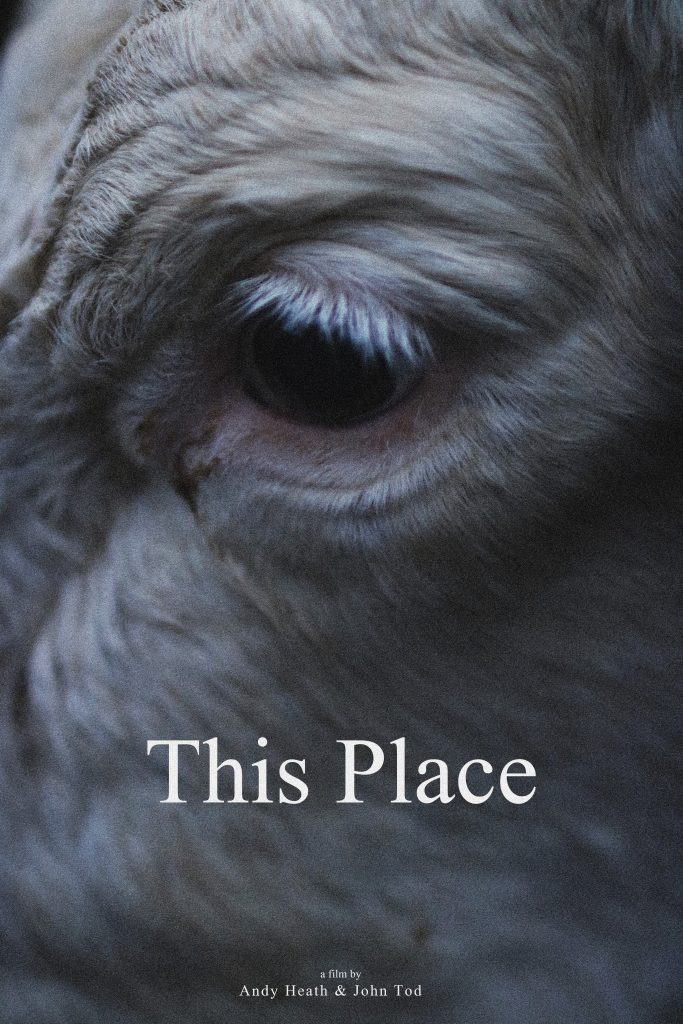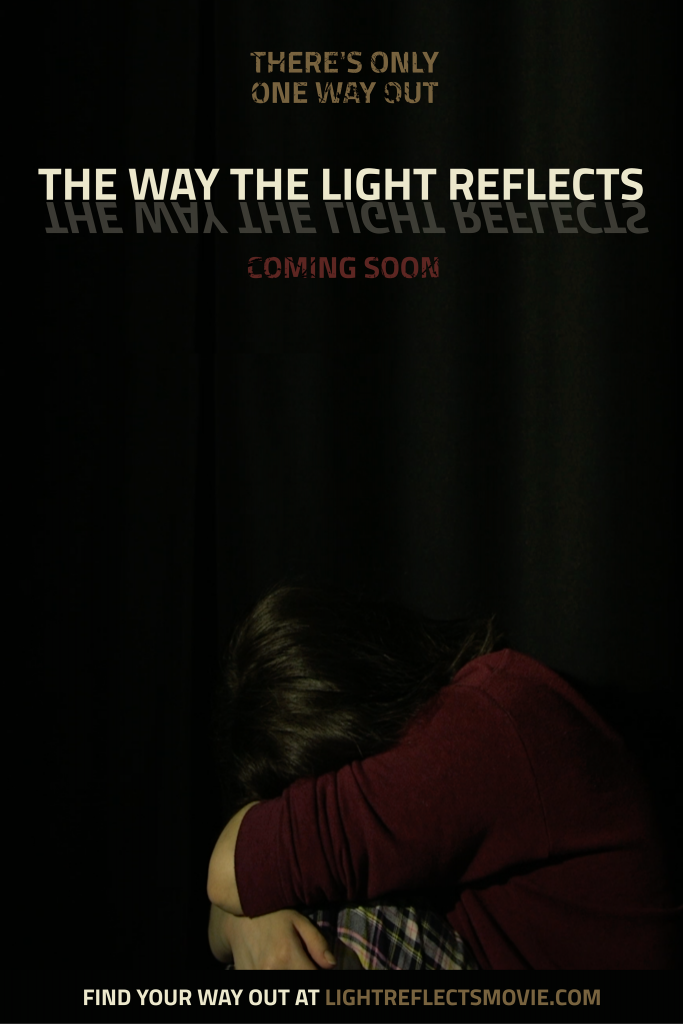
From final film productions and mixed media research projects to vlogs and audiovisual essays, scroll through and enjoy what the class of 2020 has to offer.
No Life Too Small is a poignant short documentary centring on the owner and founder of The Liverpool Vets, Danielle Greenberg, and addresses the more challenging aspects of the veterinary profession.
“The choice to film a documentary, rather than another fiction film, was rooted in our desire to chronicle real lives and to lift the lid on some aspect of society. We came across The Liverpool Vets and Danielle Greenberg due to her selfless work helping the pets belonging to the rough sleepers in Liverpool. Danielle’s openness and candour not only allowed us to capture her and her amazing team at work, but gave us the frank interview that we wanted. The veterinary profession is often looked upon as a ‘cute’ job, but we wanted to focus on the more difficult side of the profession including the effects the day to day challenges have on mental health. A massive thank you to Danielle and all the team at The Liverpool Vets!”
By Laura Clegg-Prada, Vicky Cottrell, Hannah Dickenson, Ryan Kershaw, Lily Thompson and Rebecca Tully
No Life Too Small website: https://nolifetoosmall.wixsite.com/mysite

Film and Mental Health tackles the use of cinematherapy and examines how the negative portrayals of mental health patients, institutes, and therapists have created an overall pessimistic public outlook of mental health.
“Having experienced mental health issues for many years and seeing close ones struggling, I felt an injustice towards the (mis)representation of mental health patients, institutions, and therapists on screen. I noticed that these characters and storylines were the extremes of living with a mental health disorder and even demonised the people and places associated with them. However, through cinematherapy, I learned that films that do not tackle mental health disorders can aid in patient therapy to provide hope and guidance in overcoming their hardships. I highly enjoyed speaking with Dr. Emma Ashworth at the university who gave her insight into the issues with the portrayals of disorders and hospitals on screen. Creating the audiovisual essay allowed my research and findings to be displayed visually and reveals the hidden falsifications presented to the public about mental health disorders.”
By Kat Morrison

Ruiner. A brutal attack, a scorned actor, and backstabbing of Shakespearean proportions.
By Claudia Cutiño Cortés and Eoin McKenna


This Place – Isolated amidst the British countryside resides a small dairy farm occupied by two sisters. While one sister continues to work as normal, the other experiences a powerful moment of realisation. Andy and John will be entering this film into festivals, and so are only able to share the trailer.
“We both found ourselves at that stage where we are entering a new chapter of our lives. That thought can be daunting and comes with a lot of uncertainty of which direction we may be heading. Trying to convey this feeling in an honest and unbiased way gave inspiration for what we wanted to explore in our film. Visiting the farm in the pre-production stage we were fascinated to learn and, in a sense, experience the working lifestyle of a dairy farmer first-hand. This allowed for a better understanding of how to capture the process of a farmer’s daily routine, and also drove us to try and capture the farms surprisingly calm and eerily silent atmosphere. We utilised this atmosphere by sensorially heightening the environment of the farm, crafting a world which relies on aesthetics over dialogue.”
By Andy Heath and John Tod

The Gateway was made with oscillation between relevant theoretical discourse and its practice in mind.
“The piece supports arguments I made through my thesis – about the individual working components of the audio-visual language and the disparity of their cohesion in ‘Scenes of Dread’ – a subsidiary of the horror film. A special thanks to Johnny Bridge, who is introduced in this film. A glittering performance that manifested the character from the page to the screen exceptionally.”
By Sam Farrow

Darren Aronofsky: An Auteur Director is an audiovisual essay exploring the auteurism of acclaimed director Darren Aronofsky. Although he only has seven directing credits, each one of his films is swathed in cinematic poetry and psychological messaging.
“The way Aronofsky constructs the storytelling of his films has always stood out to me. When I first watched Requiem for a Dream a few years back I was instantly compelled to watch the rest of his work, which all seemingly carry consistent themes throughout. I decided to base my vlog on the work of the director as an auteur to fully understand the many techniques he uses to capture the audience as effectively as he does.”
By Ryan Kershaw

Final film projects give students the chance to show off the array of skills and techniques they have both acquired and developed over the past three years. Their refined knowledge of film language and theory also translates into these final pieces.
Under the Roots sees two criminals hiding out in the woods after stealing a briefcase; but not is all what it seems in this mysterious place as reality, illusion and madness become indistinguishable for the two men.
“We’d like to thank our two leading men, David Loy and Eoin McKenna, for their incredible work. Their dedication to the roles from day one made our jobs so much easier and, overall, made us four incredibly happy filmmakers. We had a great time making this film at the beginning of 2020 and we have all learnt more from this than any other project we’ve worked on by a mile. We hope you enjoy this film as much as we enjoyed making it.”
By Johnny Bridge, Sam Farrow, Matthew Issa and Harry Griffiths

The Road is an audiovisual experiment exploring the effects of both the lack and presence of sound within the horror and thriller genre.
“This MMR piece was a very interesting and enjoyable project. I chose this subject because of my interests in the horror genre and the effect music can have on the audience, thus I wanted to create a film that served as an opening scene to a horror film and layer it with four different pieces of music inspired by classic horror scores. I took on the roles of director, camera operator, editor and producer which was challenging at times but always exciting. I would like to thank Noel Manley who acted in the project and who created the music for each piece, and Joel Manley who was a location scout and second assistant throughout the process. This entire project was a very exciting and enjoyable experience from which I learned a great deal. I am very proud of the final product and all that we accomplished.”
By Hannah Dickenson


The Way the Light Reflects sees Mallory waking up in a room she doesn’t recognise at a time she cannot recall, and she stumbles around in the darkness trying to find her way out. Days go by without food or sunlight and she is about to give up hope until she hears a familiar voice through the walls. Sometimes people will do anything they can to keep you…
“I was motivated to tell this story as I wanted to bring light to the reality of domestic abuse. The film acts as one long metaphor so that the audience can see how someone can be both physically and mentally trapped in a relationship. The room Mallory is trapped in is the physical manifestation of her inability to leave the relationship, complete with fake doors and false ends that convince her she can get out. The room can be viewed as a character in its own right, as it changes consistently to manipulate her, much like an abuser. What I enjoyed most about making the film was the personal creative process. I was able to be as imaginative with the script as I wanted and I was able to film visually interesting scenes that I may not have been able to achieve if I had continued with a project I was not as passionate about.”
By India Jones

Shutter Island – Truths and Lies is an audiovisual essay centring on the use of motifs in Martin Scorsese’s Shutter Island. It is principally an exploration of how water and fire are used to represent truths and lies, respectively, in relation to Andrew/Teddy’s mental health disorder.
“This is the first audiovisual essay I made and it was created as part of the AV essay module in my second year. I enjoyed undertaking further research into a film I already loved and found it interesting to gain a deeper understanding of the nuances and deeper meaning of the film. The use of visual motifs in this film made for great visual material to compile in order to underpin and highlight the arguments I was making – an approach you cannot take when writing a traditional essay on paper.”
By Vicky Cottrell

2020 explores peoples’ shared fear of technology, the impacts and effects it can have on us as people, and the sheer volume of pain it can cause.
“Technology can be amazing, but we wanted to show an extreme, intensified reality that could easily occur in the society that we live in. We all really enjoyed the production process as it’s satisfying to see all our hard work pay off in the end in the form of a short film. It was also enriching for us in terms of cinematography as we put a lot of focus and time into making sure the shots conveyed exactly what we wanted, whether that be by the colour, the framing or the use of space. One thing we struggled with was the race against time we faced during post-production due to the pandemic. We were grateful we managed to finish everything.”
By Dale Riley, Natalie Flower, Hannah Mooney and Daniel Newsham

Audiovisual essays are an emerging medium through which students can communicate their ideas and research in a much more engaging and creative way compared to a traditional written essay.
Psychopathy: The “Go To” Villain Mental Disorder is an audiovisual essay which examines the depictions of psychopaths in mainstream film and television, and unpacks the inaccuracies in relation to academic texts.
“In this audiovisual essay I intended on looking at the complex psyche of some of the most famous villains in film. I aimed to clearly explain what makes those villains tick and how accurate their representation is to the mental disorder which is psychopathy. Whilst making the audiovisual essay I stumbled upon many challenges such as finding high quality footage, shaping the project into the length given, and arranging the voiceover and visuals. In conclusion, the AV essay resulted in a smooth running piece with a slightly creepy feel, fitting in well with the topic.”
By Nadia Parpova


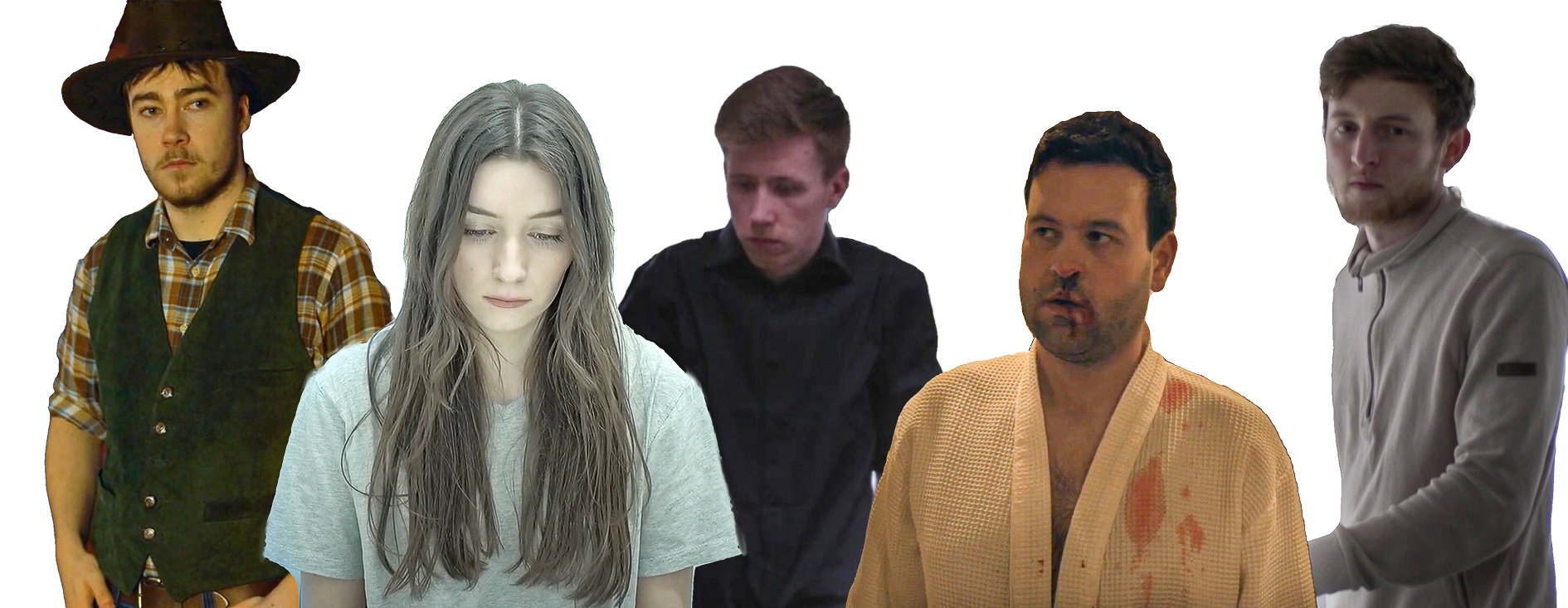
Louis (Be The Cowboy), Alex (Reverie), Frank (2020), Terrence (Ruiner), Malcom (2020)
The Birth of a Black Independent Cinema explores and discusses the contrasts between Within Our Gates (1920) and D.W. Griffiths’s controversial The Birth of a Nation (1915). The film focuses on the success of Oscar Micheaux and his impact on black independent cinema as well as the black experience.
“I chose this topic due to my interest in the representation of race in film. I wanted to research the origins of black independent cinema to broaden my understanding of the struggles African Americans faced in order to illustrate an authentic image of themselves and their culture on screen. Ultimately, I enjoyed learning about Oscar Micheaux and the controversy surrounding his films that benefitted black communities within a predominantly white society.”
By Laura Clegg-Prada

Turning the Wolf of Wall Street into Different Genres is an audiovisual essay which conveys the power of editing through turning a well-known film into different genres.
“Video editing is what got me into pursuing study into the film industry and I have been self-taught since the age of 15/16. When the chance came to fully create a project conveying whatever we desired, I took the opportunity to show my skills and complete a challenge. I enjoyed the whole process but especially whenever I received feedback from my tutor and peers and how well I edited the project. It almost felt full circle as when I first began editing I almost gave up from lack of confidence and not believing in myself. This project proved otherwise.”
By Akira Lowther

Disney and Representation of Women is an audiovisual essay which asks the question ‘Has the representation of women changed in Disney films from 1937 to 2019?’
“Like many people, I have watched Disney films from a young age and have always been a fan of the films. I’ve enjoyed seeing how much characters have changed over the years, with new characters being created or old characters being reworked to fit in with our society today. Seeing this change, particularly in the female characters, inspired me to create an audiovisual essay to highlight the shift in tone and changes in depictions since the very first animated feature film in 1937 (Snow White and the Seven Dwarfs). I really enjoyed making this AV essay and exploring the films and female characters. Through the process of creating it I have learnt a lot about the women as they have adapted to fit into society.”
By Megan Williams

Be the Cowboy features Louis, a guy with a penchant for the cowboy lifestyle. After getting into a confrontation with “The Outlaw” at a bar and arguing with his friend Jessie, Louis searches for a way to pursue his lifestyle in a safer way. Will he ever get the stand-off he desires?
“Through the creation of Be The Cowboy we tried to convey the hardship that is felt when trying to adapt to adult life, which is a feeling that is felt by many, especially in the 18-24 demographic. The intent of portraying this morale is to express to the audience that feeling immature is a perfectly normal practice as long as they are able to accept that they can grow using their maturity as a vessel to help explore their own individuality. The process of making Be The Cowboy was difficult due to its frequent change of scenery, however it was fun because of the hard work the cast and crew put into it. Working with cowboy props such as guns, fake whiskey, and costumes was a challenge we had not put much effort into in previous years.”
By Nadia Parpova, Harvey Long, Michael Grier, Aaron Whisker and Charlie Karisa

Reverie centres on Alex, a 21 year old girl who is suffering from the loss of her best friend, Sophie. Because of this she suffers from insomnia, struggling to separate her dream state and reality. Things start to get out of control when her memory of Sophie warps and haunts her.
“The story of Reverie is about a girl who suffers from extreme insomnia. We chose the subject of insomnia because it is something as a group we have all experienced. One part of the production we all enjoyed was the shoot at Roxy’s. It was really cool to have full control of such a fun and creative location.”
By Jack Auld, Kynan Birchall, Ryan Hooker, Matteo Genovese and Sean Smith

Taste or Timing is an audiovisual project which explores the appeal of food in film.
“I chose this topic because I just had to question where I am getting gratification in these montage sequences, challenging the effects of editing with something that strictly relies on visuals (food) was the obvious choice to answer this. The most enjoyable part was editing it all together, simple things like giving added style to resources I’m presenting is always a guilty pleasure.”
By Harvey Long

Bi Bi Bi: Erasure & Invisibility is an audiovisual essay which examines LGBTQ+ representation throughout history, with a specific focus on bisexuality and the erasure and dismissal of its legitimacy through negative or stereotypical portrayal. (Mature Content)
“Choosing this research topic was almost instinctive to me since it is something personal that I am passionate about. With this piece of interactive media, I intend to educate audiences willing to learn more about the struggle for representation and unnoticed hardships that bisexual people withstand.”
By Ryan Kershaw


